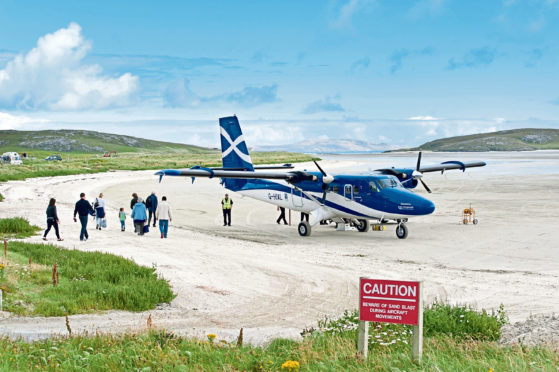
It is regarded as one of the most spectacular airport approaches in the world.
Tourists flock there to see aeroplanes arriving, while others even book a flight just to say they have been part of the world-renowned landing. It is, of course, Barra Airport, the only destination in the world for scheduled flights where the runway is on a tidal beach.
The shallow but wide bay of Traigh Mhor, which means Big Beach in English and is located at the northern tip of the island on the Outer Hebrides, has three runways set out in a triangle.
These are marked by permanent wooden posts which are submerged by the sea when the tide comes in, but the way they have been set out allows the aircraft to land into the wind, although obviously flight times vary due to the tide.
Scheduled flights began on Barra beach in 1936, but the first flight to have touched down there is recorded as being on June 14, 1933, when Captain Jimmy Orrell – who was ex-RAF – landed a Midland & Scottish Air Ferries DH Dragon at Traigh Mhor.
He was on a three-day trip to survey new landing positions for the air ambulance service, and it is believed as well as Barra, he also visited Crinan, Coll, Sollas, Stornoway and Oban.
Prior to this initial landing, the beach had been primarily used by cockle pickers, and indeed this has continued, even with the regularity of flights.
The cockle pickers and other visitors are asked to observe the windsock to check if the airport is currently in operation. Three years after that initial landing, it was given official licensing by the Air Ministry, and the first scheduled flight touched down on the beach on August 7, 1936.
It wasn’t operated by Midland & Scottish Air, who had taken that test run in 1933, but a new company, Northern & Scottish Airways, based out of Renfrew. Founder George Nicholson and chief pilot David Barclay had been struggling to find a suitable landing strip on the island, until the Northbay postmaster, John MacPherson, suggested the beach be used.
The new service had been advertised well and a single ticket for the 1936/37 winter service from Renfrew Airport was £4. A 90-day return ticket was available for £7 17s 6d.
One of the most important names in the airport’s history is Kitty MacPherson. She was manageress, more or less singlehandedly running the operation of the airport, from 1951 until 1974. She received an MBE in 1969.
Today, there is a regular service of flights to and from Barra from Glasgow.
As well as the usual daytime flights, the airport is also used for emergencies, meaning there can also be night flights. On these occasions, the pilots have to rely on reflective strips laid on the beach and vehicle headlights.
The control tower looks east towards the nearby island of Orosay, while from the rear the Atlantic can be seen sweeping on to the beach of Traigh Eais. The terminal building also boasts a cafe favoured by visitors.
Operated by Highlands and Islands Airports Limited, which in total operates 11 airports around Scotland, Barra’s airstrip stands alone for its unusualness, not just in Scotland or the UK, but in world travel, ensuring it will continue to draw international visitors eager to see the planet’s most unique airport setting.

Enjoy the convenience of having The Sunday Post delivered as a digital ePaper straight to your smartphone, tablet or computer.
Subscribe for only £5.49 a month and enjoy all the benefits of the printed paper as a digital replica.
Subscribe